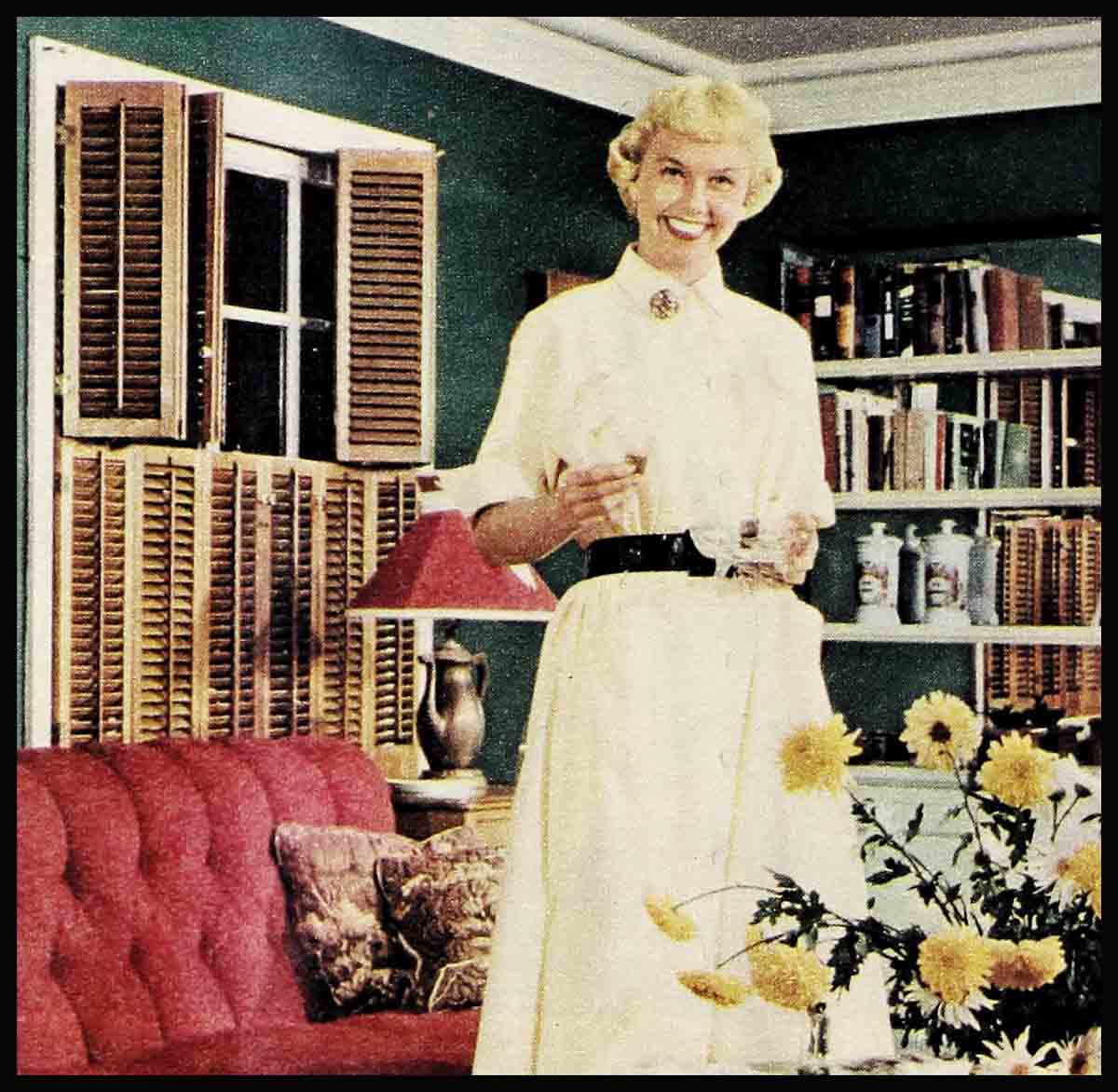
Sunny Side Up—Doris Day
When you come in the front door, right away you know this is where Doris lives. Somehow the gay colors, the warm informality reflect her engaging personality. “Only the house isn’t finished yet,” adds Doris, after a welcoming grin. “Those chairs have to be re-covered. Curtains are scheduled for the dining room. And what do you think I should do with the entrance hall?”
That’s Doris, and that’s her house. To anyone else it looks good. To Doris, there are a million things to be done. But she’s the girl in a hurry, and no time in which to do everything. “If only I had nothing to do but to shop around for fabrics and wallpaper . . .” she moans.
“You’d go crazy,” finishes husband Marty Melcher, and Doris laughingly confesses that he’s right.
Surely, gradually, the changes will be made, but there will always be something else to do, and that’s what makes it fun.
In the meantime, despite Doris’s protestations, her house is delightful. It’s on a quiet, tree-shaded street, the white Georgian Colonial exterior, with its green trim, offering a dignified welcome. The small entrance hall echoes the dignity, but, instead of the usual balustrade, a white partition topped by a plant-box frames the landing for the stairs that lead to the second floor. It’s successful, because the stairway has a wall on either side, and the landing makes a square turn two steps up from the hall.
To the left of the hall is the living room, and at the right a door opens into a bar. “We don’t drink,” said Doris, “so we planned to take the bar out, but that would be very expensive. We have to consider resale value, you know.” So the bar stays, and Doris is doing it in red, green, black and white. The red, green and white are combined in a plaid paper for the walls, and the black is in two chairs surrounding a round pine table on which stands a tremendous Vat 69 bottle, made into a lamp and topped with a red linen shade. Doris brings the black into the room again through dime store frames which she has painted and uses for pictures of people with whom she has worked. These line the wall behind the bar. Valances made of red moire, which she bought in the basement of a department store, top the shuttered windows, and two green leather chairs are on either side of a pine trestle table.
It’s an inviting room, but not any more so than the delightful living room. From her previous house, Doris brought two Chippendale wing chairs covered with printed cotton, a sporting scene in gray, blue, yellow and touches of red against a cocoa-colored ground. And two French Provincial cabinets flank the cherry red antique satin sofa, bearing attractive little pewter pitchers which Doris had made into lamps.
Jot down in your idea book the thought of using cabinets beside a sofa or chair instead of tables, particularly if your room is small. The cabinet, you see, provides storage for those extras that clutter up a house, and also serves as a lamp table.
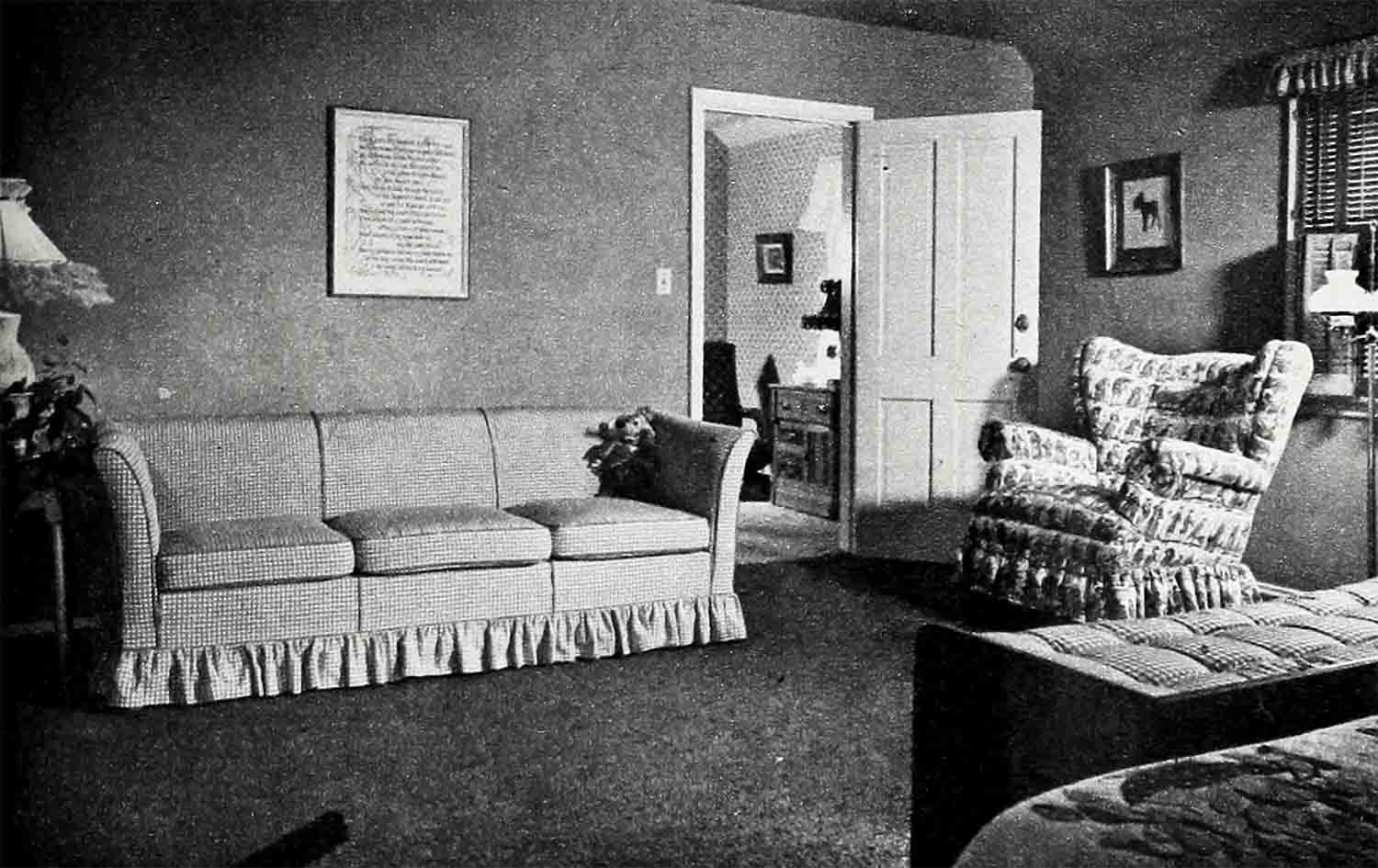
Speaking of lamps, there’s something else you can borrow. Make your own lamps from pitchers, as Doris did, or from a pair of vases, or from a couple of copper teakettles. You can buy the fixtures and wiring at any hobby or hardware shop, and by drilling a hole in the bottom of the accessory, make the conversion. Be sure that the lamp, from finial to base, is at least twenty-seven inches high so that it will provide proper illumination.
For her living room Doris chose a contrasting color scheme; green chenille carpeting and a deeper’ green for the walls, crisped with white ceiling and woodwork, perfect foils for the red sofa. A gold textured cotton lounge chair and ottoman tie in nicely, and echo the spot of yellow found in the print.
A contrasting scheme means that two colors opposite each other on the color wheel are chosen. To be successful, one must be used in larger proportion than the other—in this instance, green—and a third color may be brought in for accent, such as the yellow. An individual with exuberant personality, such as Doris, demands an exciting combination of colors, which is one of the reasons that this living room reflects her personality.
A door on one side of the white fireplace opens into the den and shelves march up the wall on the other side. Doris lined the back of the shelves with mirrors, so that you get the impression that you’re looking through the shelves into another room. It’s a neat trick that works wonderfully well, if you have a need for it.
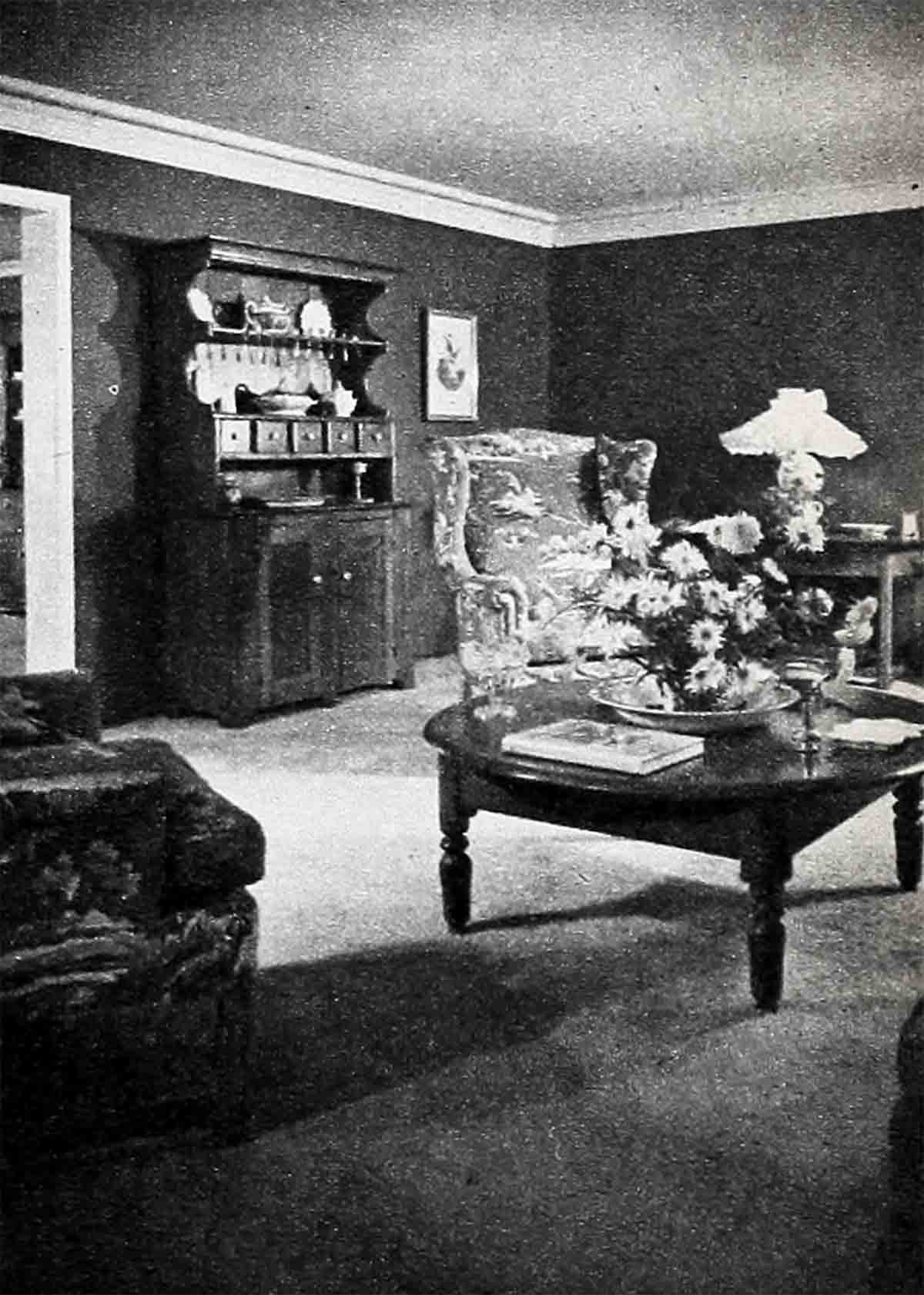
Occasional pieces in this room blend together, even though Doris has two French Provincial end tables beside the sofa; a round oak coffee table complemented with bowl of flowers, ash trays, Ronson lighter, but still leaving plenty of room for party refreshments, in front of it; an Early American Welsh cupboard against one wall, and a pine Early American table against the other. Why do all these pieces, despite their various heritages go together? Because they’re all informal styles. You can mix periods and have a successful decorating scheme but you cannot mix formal and informal styles.
Actually, the round coffee table belongs to no period. It’s just nicely designed. But you can achieve the same type of piece if you keep a sharp lookout for old, round, dining tables. When you find one that has the diameter you want, buy it, then cut it down to coffee table height by eliminating the middle section of the legs. To give it a new finish, buy a good paint remover. Then after you have cleaned and scraped the surface down to the wood, sand it to satin smoothness, then stain it or wax it, depending upon the finish you want. If it’s stain you choose, clear Shellac adds a protective coat to your table, but if you object to the gloss, cut it down with steel wool and a final application of paste wax.
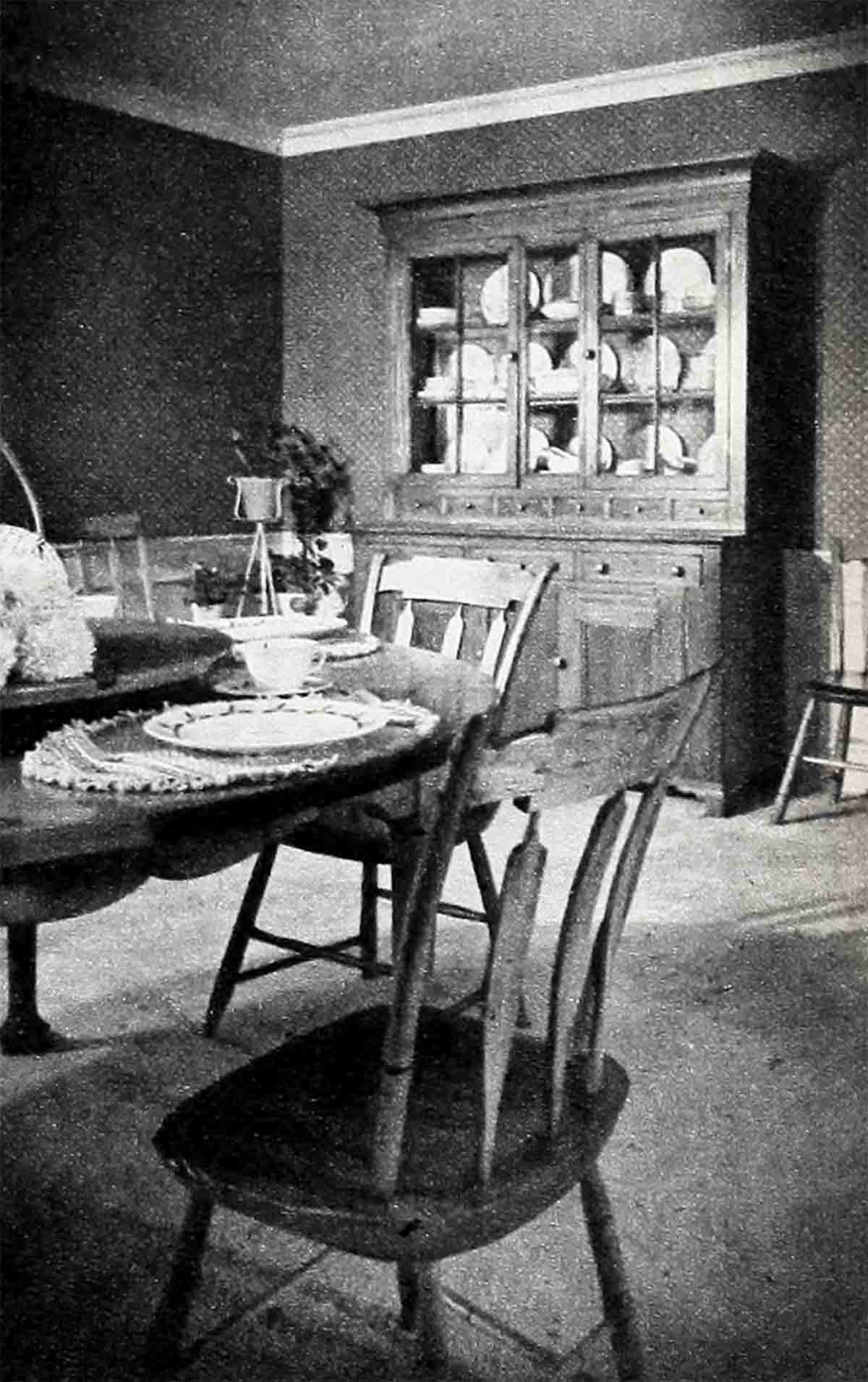
The shutters of the room please Doris particularly. “They’re so informal,” she says, “and actually, you don’t miss draperies with these at the windows. But I’m getting draperies as soon as I have a little time,” she adds hastily.
One of the reasons Doris likes this room is that it’s filled with the things she loves. For instance, one day she and Marty had a semi-spat over the furnishing. Finally Marty, when the argument reached a climax, growled under his breath and made a dramatic exit. Half an hour later Doris was called to the phone. “Honey,” said Marty, “I’ve found a really terrific something or other—some kind of a cupboard.”
It was a perfectly beautiful Welsh cupboard, complete with spoon rack and spice drawers, and the only furnishing piece that Marty has ever selected by himself. Nothing could tempt Doris to part with it!
“This green thumbprint pitcher,” Doris indicated on the shelf, “belonged to my great grandmother. And my father sent me this little coffee maker which was left in an apartment which he owns. This Russian wooden bowl belonged to my aunt, and the Pembroke table in the hall came from an old woman who worked for my grandmother. It was an ugly green, but we stripped it down to the wood, and see how lovely it is now.” Of such things is a home made.
Vibrant as is the living room, the den offers a complete change of pace, being done in practically a monotone. Sculptured beige carpeting echoes the wood tones of the paneling on all four walls, and a natural leather sectional sofa practically matches. A green leather chair offers a bit of contrast, however, as do the subdued floral draperies in a heavy repp weave. Here, too, is a television set, plus a pine trestle table bearing a huge copper lamp. Needless to say, here’s where son Terry and his friends hang out, watching their favorite shows and indulging in games of canasta from time to time.
Because the living room opens onto the dining room, Doris chose the same color scheme of red, green and white, but used the colors differently. The red’s on the wall in a wonderful, little Provincial print paper above white wainscoting. Woodwork and ceiling are all white, and the green carpeting’s the same as that in the living room.
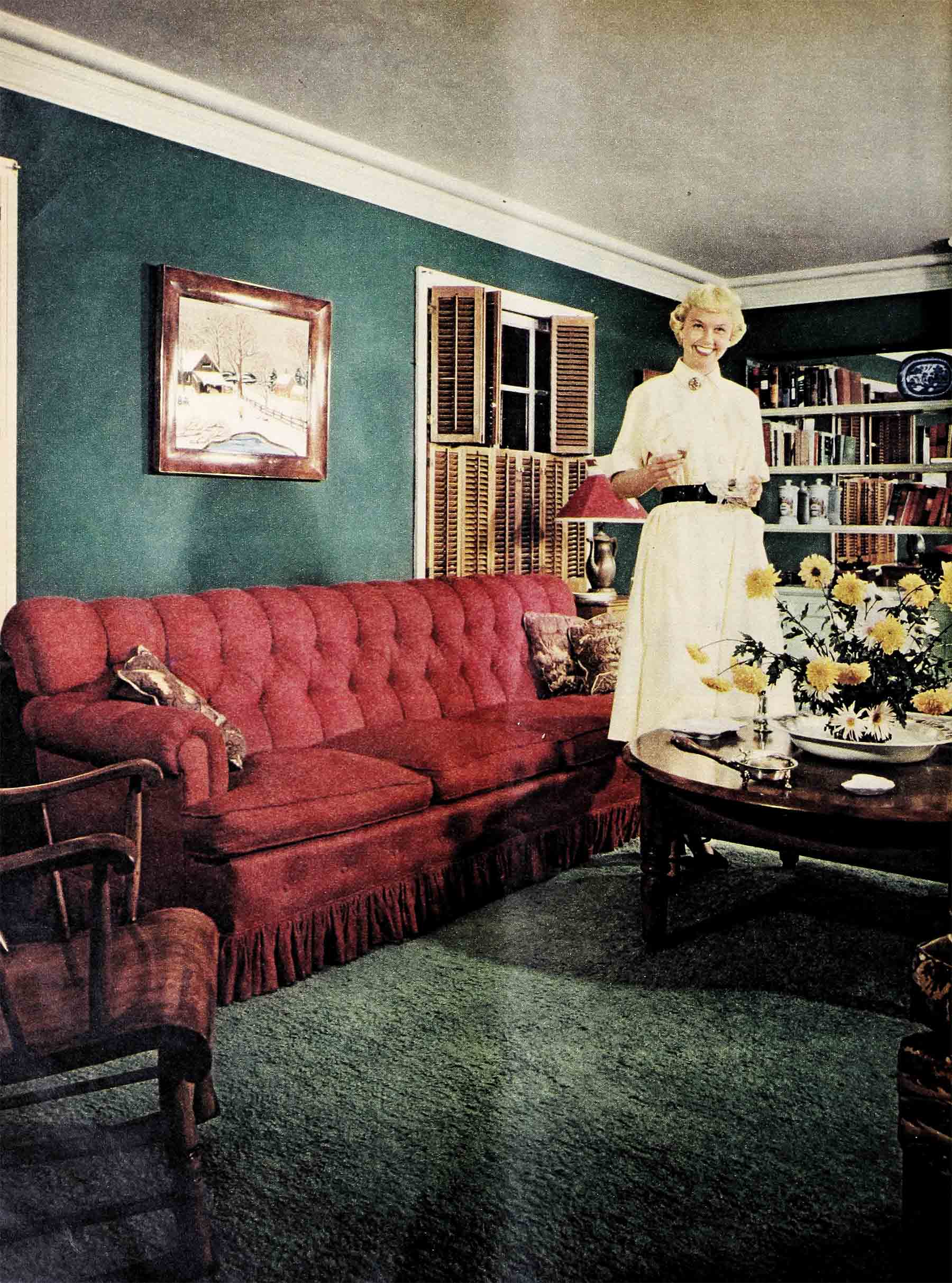
For furnishings, though, Doris stayed with Early American, in a round pine dining table topped with a lazy Susan, surrounded by old, hand-hewn pine chairs. A large pine breakfront in the same style displays Doris’s china and glassware, and ‘stores her linens and silver.
Windows in the rear wall of the dining room look out on the garden, and a door and window in the side wall open onto a festive, screened-in porch. Underneath this window and continuing around under the adjacent window which looks outside, Doris built a plant box. White, it matches the wainscoting and is the same height, but the greenery refreshes the whole dining room.
You could build one from plywood or pine paneling, making it the height of the window sill, the width of the window, and about eight inches deep. Build a shelf and place it inside the box about eight to ten inches below the top. On this, place a metal liner. You can fill this with soil and peat moss and plant the greenery in it, or keep the plants in their pots and fill the area around them with a combination of peat moss and soil. The latter arrangement is most satisfactory, because you can keep turning the plants so they will grow evenly, and you can replace easily those which do not flourish.
You who live in the East and Middle West will be particularly interested in the screened-in porch just outside the dining room. A shed roof with exposed beams stained a dark brown covers the area, and the two outside walls are practically all screens. There’s a brick floor, wonderfully practical, and for furniture, a dark green trestle table with two matching benches, and a round, green wrought iron, glass-topped table. Doris and Marty chose green for these pieces because the walls are yellow, edged with dark green woodwork. To emphasize the outdoor feeling, wrought iron brackets displaying pots of gay flowers, travel up the sides of the walls.
As Doris and Marty use this for an outdoor dining room, a portable barbecue takes over the cooking task, and for easy serving, a yellow formica-topped counter underlines the window area along the back wall. Doris loves to entertain here in the summer. “It’s so easy,” she declares, “and everyone has a better time when frills are eliminated.”
Of course, in the Melcher house, all the guests could move right into the kitchen and enjoy themselves, it’s so attractive! The walls, ceiling and cabinet are of knotty pine in a natural finish. A small window bay decorates the sink area, where glass bricks let in loads of light, and to the left a Dutch door leads outside. Black and cream rubber tile makes a good surface underfoot, but the most notable departure from tradition is the mirror which lines one wall above a waist-high cabinet. It seems to double the size of the room.
The family takes advantage of these pleasant surroundings, by having breakfasts and lunches at the round table surrounded by a built-in bench tucked into a kitchen corner.
The master bedroom, fresh and crisp and charming, again reflects Doris’s personality, even though the colors are different from the rest of the house. Here, she’s turned to blue, instead of green, but the red and white continues. It’s successful because it’s simple.
Doris had a huge, old-fashioned, platform rocker which she had reupholstered in a red and blue documentary print on white ground. It’s toile, and makes a very handsome piece indeed. Red and white checked cotton taffeta goes beautifully with the print, so Doris put it on the sofa, used it for valances above the shuttered windows, repeated it on a pad that’s on a chest at the foot of the bed. Finally, it will be used on the bed headboard, which is on the list of things to come. Meanwhile, a beautiful white, quilted spread with blue flowers appliqued in four corners covers the bed—a gift from her aunt. Setting off all the red and white are soft blue walls and ceiling, trimmed with white woodwork, and a deeper blue in the chenille carpeting.
For a bedroom lamp, Doris chose an old bowl and pitcher, transformed the pitcher into a lamp, and set it in the bowl filled with philodendron, which adds a nice touch of greenery to the room.
Outside the bedroom, the walls of stair landing and hallway are papered with a Provincial clover-leaf design in gray and red, with green chenille carpeting on the floor, and a few nice old furniture pieces setting the atmosphere. A little Victorian marble-topped chest looks right at home next to a tapestry-covered platform rocker that belongs to Doris’s mother. A milk-glass setting hen and an old oil lamp converted to electricity complete the picture.
For her son Terry’s room, Doris had beige cottage curtains made of rayon butcher linen. They’re trimmed with a red, white and green provincial print, which is used also for the valance, and for a pad on a cricket chair. The quilted cotton spread ties in, with its colors of green, yellow and blue and the walls are covered with a beige grasscloth paper. For furniture Doris selected sturdy maple for desk, bed and the built-in chest along one wall which boasts a dropleaf for Terry’s electric train.
“Someday,” says Doris, “I’ll have everything in the house exactly the way I want it,” at which Marty nods his head happily. He knows she’s kidding herself, that always there’ll be some change to be made. “Oh, well,” he remarks philosophically, “she can dream, can’t she?”
THE END
It is a quote. PHOTOPLAY MAGAZINE APRIL 1952




